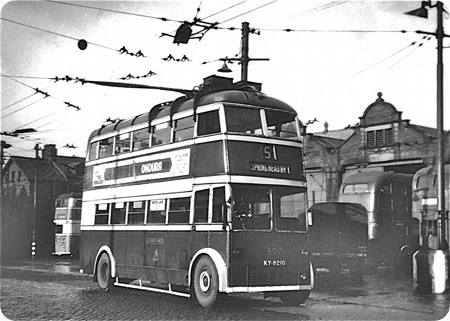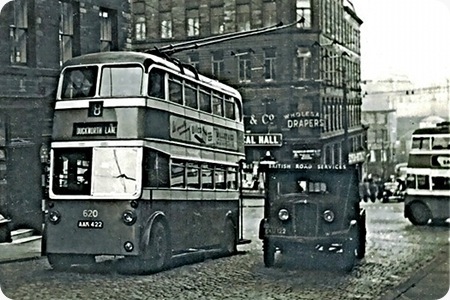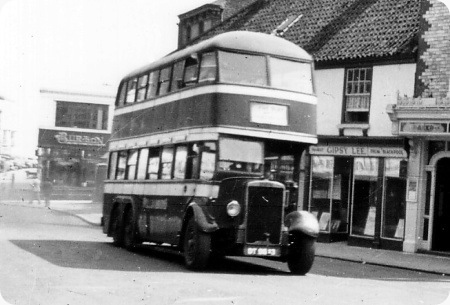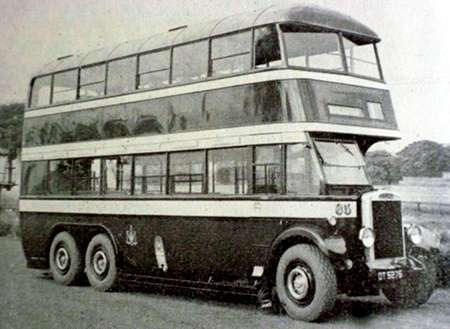Bradford Corporation – AEC 661T – KY 8210 – 607 & AAK 422 – 620
Bradford Corporation Transport Bradford Corporation Transport
1934 1935
AEC 661T AEC 661T
English Electric H32/26R NCB H30/26R (rebuilt 1949)
This photo of Bradford “Regen” 607 was taken in 1944 outside Duckworth Lane depot and shows this trolleybus in dark blue with war time white paint and headlamp masks. The overhead wiring has flash guards fitted on the points as a blackout precaution. Also present are two Bradford motor buses in khaki livery which did not apply to any of the trolleybuses in the fleet. The bus on the left is a 1939 Daimler COG6/English Electric Company and the bus on the right is a 1936 Daimler COG6/Weymann. Behind 607 there is a parked 1935 “Regen” in the “new blue” livery introduced by Bradford in 1942. “New blue” was the description used by the Bradford engineering staff during the early years of this light blue and cream livery which remained the standard in Bradford up to April 1972 when WYPTE took over all the Corporation fleets in West Yorkshire.
From my research I have found that 607 had a serious front accident in late December 1935 and was rebuilt with a full width cab and seating reduced to 58. The control contactors and shunt resistors were relocated from the chassis side to the cab. All the “Regens” except 632 were originally built with a half cab and 60 seats but all were rebuilt to full cabs as 607 in 1937/38 and the seating reduced to 58.
Perversely due to the cramped half cabs, the main circuit breakers were located on the roof trolley gantry and operated by levers in the drivers‘ cab connected by Boden cables with steel wires. Overtime these steel wires extended and often broke rendering the trolleybus inert and an operational disaster. It is surprising that Bradford did not fit cab located circuit breakers at the time when the full bulkheads were fitted. This work however did start in 1942 for some “Regens” but was not done to 607 where the large boxes are the circuit breakers which can be seen on the roof. 607 was withdrawn for re-bodying in June 1945 and returned to service with a Northern Coachbuilders Mark 1 56 seat body in September 1946.
The photo of 620 now with a 1949 Northern Coachbuilders Mark 2 56 seat body shows it accelerating noisily up Godwin Street in Bradford City Centre in October 1952. In the background is a Brush bodied “Regen” on the Allerton service to the City Centre terminus. 620 still wears the glorious Tattam livery with cream bands, black beading and yellow lining. It soon lost its cream bands, was moved from Duckworth Lane depot to Thornbury in 1954 and then could be seen elsewhere in the City, Sadly 620 was withdrawn from service prematurely in April 1958 due to a serious accident when it skidded and overturned on the Clayton route. Other “Regens” with NCB bodies lasted until November 1962 having given 28 years service, albeit with a troubled number of early years until re-bodied in the forties.
Happy days, these unique “Regens” with their wailing and humming sound will always remain etched in my mind.
Photographs and Copy contributed by Richard Fieldhouse
Bus tickets issued by this operator can be viewed here.
01/02/11 – 18:41
What a treat to see the 2 "Regen" Bradford trolleybuses, and thanks to Richard for the technical data concerning the circuit breakers and full cab rebuilding.
It all goes to emphasise the points I made about the severe problems with these early EEC metal bodies, mentioned in my own "Regen" post.
In their rebodied form, I spent hours travelling in them, and, like Richard, will never forget their distinctive wailing sound. Also of interest is the rear of the EEC bodied COG6. My recent article on English Electric Bus Bodies mentions the 1937 re-design, and the well rounded rear dome of this bus illustrates this very well. There were very few takers for this design. I can only think of TD5s at Barrow, and lowbridge "Regents" at Southend. Anyone know of any more? The previous design had a very upright dome as can be seen on the "new blue" AAK "Regen" to the left of 607.
My home was about a mile and a Half from Duckworth Lane depot, shown here, and I was about five when the photo was taken!
John Whitaker
01/02/11 – 18:47
Fascinating submission. This is not the first one which mentions noisy trolleybuses, yet I cannot ever recall hearing more than the odd whine and swish from them, and I must have visited and travelled on them in some 10 towns which operated them. Any reason for the noise?.
I must confess that noise would have given individuality to an otherwise usually rather bland form of travel.
Even so, I was always impressed by their 0-60 acceleration and indeed used to ride on the last trolleybus from Croydon to Mitcham which went flat out across the common (about 60) silently, bar the singing of the poles/wires and the vibration from a far from new class of trolleys. On reflection, I wonder if I saw the girlfriend, who gave me this routine, for longer than I might, simply for the trolleybus experience!!
Chris Hebbron
02/02/11 – 06:14
Chris, I think the noise was generated by the double reduction gears in the rear axle differential that were straight cut teeth. Similar to tram motor gearing so a similar noise. I am pleased you found these Regens pictures interesting.
Richard Fieldhouse
05/02/11 – 16:07
Glasgow must have had very quiet trolleybuses. My dad can remember them being almost silent to pedestrians and they became known as ‘the silent death’. I hadn’t ever heard this mentioned anywhere else but reading Ken Houstin’s excellent ‘The Corporation Bus’ (Grosvenor House, £9.99 from Waterstones) lastnight I came across mention of one Dionne Warwick vs Glasgow Corporation. It seems the singer left the Glasgow Odeon after a concert using the back door on to West Nile Street. This being shrouded in thick fog, she didn’t hear or see a trolleybus and was struck by it and an out-of-court settlement smoothed things over!
Scott Anderson
29/04/11 – 06:49
One of the class lasted until 1965 having become trainer no. 060 in 1962. This was the former 597 with an NCB (mk2) body. I photographed it in this role outside Thornbury depot in July 1963. On withdrawal in 1965 it had achieved almost 31 years of service.
No. 603 was repainted in the 1911 style livery to celebrate Bradford’s Golden Jubilee in 1961. According to Stanley King no. 603 attained 1 million miles in service on 24 April 1962.
Malcolm Wells
26/03/12 – 07:53
I have just put together a gallery to commemorate 40 years since the end of Bradford trolleybuses. This incorporates over 500 photos including a section on the ‘Regens’ which I hope will shed some new light on the issues they experienced. Richard Fieldhouse has given me some useful information which has helped to interpret the photos, a lot of which relate to the structure of the body.
There is also route-by-route coverage. The gallery can be found at: //davidbeilby.zenfolio.com/
Hope you enjoy it!
David Beilby
26/03/12 – 13:21
David, the Bradford additions to your gallery are absolutely superb. Many thanks for your efforts, and particularly the EEC views, which to us Bradford enthusiasts are unbelievable. We would never have believed that such a wonderful archive even existed, let alone become available.
The Regens have always been my main transport "love", as I grew up with them, and have previously said on a 606 posting, they were "personal friends" in the way that true transport enthusiasts will readily understand.
John Whitaker
27/03/12 – 07:17
Thx, David B, for putting Bradford’s trolleybuses on your website. Interestingly, the range 597-632 is virtually identical to (2)16-(2)24 (and especially (2)24 in Portsmouth Corporation’s fleet. Bradford re-bodied them around the end of the war, but Pompey’s carried their original bodies until they were scrapped, mainly in the 1957-8 period.
What was news to me were the five AEC ‘Q’ trolleybuses, presumably all with English Electric bodies, although whoever built the ‘Q’ (trolley)bus bodies, usually seemed to make them all look very similar. Bradford’s ‘Q’, 633, had a relatively short life (1934-1942). To withdraw a vehicle in mid-war would seem to indicate a really serious deficiency somewhere. The clue might lie with Southend’s ‘Q’ trolleybus No. 123, originally on hire from AEC Ltd., from 1934. It was rebuilt by Sunny Dawes in 1943 and again by Beale in 1945, finally being withdrawn in 1949. Intriguingly, Peter Gould’s website shows this vehicle as being a lowbridge example.
Chris Hebbron
27/03/12 – 15:47
Chris. Bradfords Regens were the first EEC metal framed trolleybus bodies. Like their BCN Leyland TD3 cousins, the bodies were literally shaken to pieces after 10 years, due to body weakness, cobbled streets, and the double reduction drive. EEC had learnt a few lessons by the time PCT received their’s, and there was a redesign in 1937, as exemplified by 635 etc in the BCPT fleet.
the Q ("Queenie", No 633) was sold to South Shields in 1942, where she ran until c.1950. She was non standard in Bradford, regarded as draughty, and there were problems with the front overhang. A MOWT directive instructed BCPT to sell earlier 6 wheelers, and 633, South Shields and Newcastle being the recipients in 1942, and 1945.
Bradford had, of course, received 10 Sunbeam MF2s in 1942 under MOWT directive, which enabled these transactions to proceed. I refer to the "Joburghs", 693-702.
We could write paragraphs on the "Regens", so I will leave it there!
John Whitaker
28/03/12 – 08:31
Thanks, John, for filling in the gaps. We tend to forget cobbled streets and the effect they had on vehicles of the time, and probably to a lesser extent now as well. I sometimes wonder if East End of London cobbles were a prime reason for London Transport’s chassisless bodies coming into service. Although one or two small orders had their weaknesses, most survived the punishment well, although a large maintenance workforce would have helped.
Chris Hebbron
28/03/12 – 18:23
It has always amazed me Chris, that the LPTB chassisless trolleys performed as well as they did, and that the concept was not followed up apart from, I suppose, the RM input. Interesting point!
Re. Bradford`s Q trolley, I think an identical, or near identical body was fitted to the Halifax Motorbus Q. Have a look on David`s site. Most Q motorbuses had MCW bodies as did Bradford`s.
As you say, Southend`s EEC Q was lowbridge, as were the earlier 661Ts! What a fascinating fleet that was!
re. Portsmouth, I am assuming that their EE bodied 5 bay AEC 661T trolleys were metal framed, as I always assumed, perhaps wrongly, that they were. The earlier 6bay EEC bodies, and their 6 wheel equivalents were definitely composite, as the BCPT ones, delivered from November 1934, were definitely the first trolleys from EEC with metal framing.The Burnley C and N Titans were their first all metal motorbus bodies, and caused horrendous problems, as has been stated before. What a great hobby interest we share!!
John Whitaker
02/12/14 – 16:14
I always thought these Bradford Corporation AEC 661Ts 597 to 632 (built 1934/35) with double-reduction differential rear axle drives were unique. This belief was wrong as I have now found details in the recently published Portsmouth Trolleybus book by David R H Bowler that their AEC 661Ts 16 to 24 were also fitted with double-reduction drives and also made a loud noise when running. These Portsmouth trolleybuses with English Electric bodies were built in 1935 and followed the Bradford order and were similar in appearance. By 1936 I believe a worm drive with stronger bearings had emerged from AEC, no doubt due to London Transport influence, and future orders by Bradford and Portsmouth were for AEC 661Ts with worm drives which were much quieter in their operation.
Richard Fieldhouse
03/12/14 – 05:39
Nice to hear from you again, Richard. If you go to ‘More Pages’ on this website, then Old Bus Sounds, the first item is a Portsmouth trolleybus of the later type, but still with a noisy rear axle, albeit because it was worn, perhaps, near the end of its days! It’s certainly not a silent one! I confess that I never heard one of the 16-24 type, to my knowledge. They didn’t possess battery power movement and were usually relegated to peak time workings and were scrapped earlier than would otherwise have been the case. They also had a neglected air about them, with faded paintwork. Sad, because I always thought they had the most attractive bodies of all of Pompey’s trolleybus fleet.
Chris Hebbron
03/12/14 – 10:26
Many thanks Chris for your kind words and advice on the Bus Sound section for the sound of a Portsmouth AEC 661T/Craven trolleybus. I believe the General Manager Mr Ben Hall of Portsmouth was very wise to specify at a late stage Battery Traction availability for the large AEC 661T/Craven order. With the damage due to bombing during World War II, the trolleybuses in Portsmouth were still able to operate by using temporary turning points on battery power. Regarding trolleybus noise, this was also common in Bradford with some of their AEC 661Ts with worn worm drives adding to the "music". It made every trolleybus seem to be a character. Interestingly the Karrier E4s (677 to 692; built 1938) used to make a more growling noise even when newly overhauled. Perhaps these were the bass section.
Richard Fieldhouse





